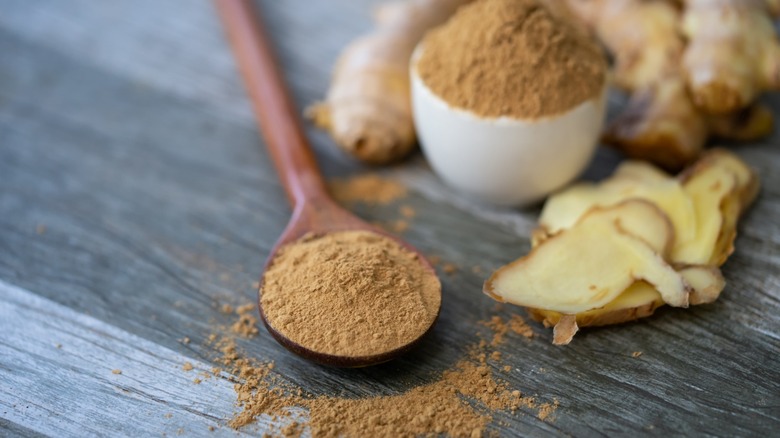Does Eating This Spice Really Help With Joint Pain?
We may receive a commission on purchases made from links.
Ginger isn't just one of the seasonings that make up a pumpkin spice blend; it's also a food with some proven medicinal properties. Gingerol, a component in ginger that amps up the efficiency of gastric motility, might just be the way to help hangover nausea or queasiness associated with pregnancy or even a stomach bug. This is why your mom encouraged you to sip ginger ale when you were sick as a child — even though most popular ginger ales on the market contain scant amounts of actual ginger root.
There's emerging research that ginger root might be able to help those with chronic joint pain, arthritis, or certain autoimmune disorders (via Healthline). A narrative review published in Phytotherapy Research further indicates that sufferers of period pain or migraines might even benefit from this all-natural remedy, either in lieu of or in conjunction with prescription or over-the-counter pain relievers. There are a number of possible explanations for how ginger might help combat mild to moderate pain, including prostaglandin inhibition, antioxidant effects, and acting as agonists at vanilloid receptors. Most of these chemical reactions work on inflammation, which is a critical component of joint pain.
In some randomized controlled trials, patients who ingested ginger root experienced an analgesic effect that placebo patients did not. Yet, these results have not always been replicable, and scientists aren't quite ready to make any groundbreaking statements definitively linking ginger to pain relief. It's a promising avenue of research, however, given the fact that ginger is a benign and low-risk treatment for many patients. It does have known drug interactions, however, so always talk to your doctor before starting any supplements, including ginger.
How to eat ginger to potentially help your joint pain
If you are trying to experiment with ginger to alleviate your aching joints and you've received the go-ahead from your doctor, know that there are a number of ways to get your dose in. Ginger capsules or ginger teas will get the job done efficiently, but, of course, you came to your foodie friends to learn how to cook with ginger! Cooking with ginger root is fun and rewarding, as its natural spice and pungent flavor give a kick to many dishes, especially those that lean in an Asian direction. Once you learn how to grate ginger root with a fork, the sky's the limit when it comes to adding fresh ginger to your stir fries, fruit salads, pickling liquids, or grain-based side dishes. How about some ginger molasses cookies, the warming flavor of which puts one right in mind of autumn? Keep in mind that you want 100% pure ginger without additives and that fresh is more potent than dried.
For pain-relieving purposes, ginger plays well with several other natural supplements that also tout alleged analgesic properties, like garlic, cinnamon, turmeric, and cayenne pepper. Again, don't start any natural treatments, no matter how harmless they seem, without first asking your medical team about it ... especially if you are mixing treatments. Assuming you got the all-clear, it's an attractive prospect to incorporate anti-inflammatory foods like ginger into your diet. You need to eat to live, so why not consume foods that have the potential to help with your pain level?

